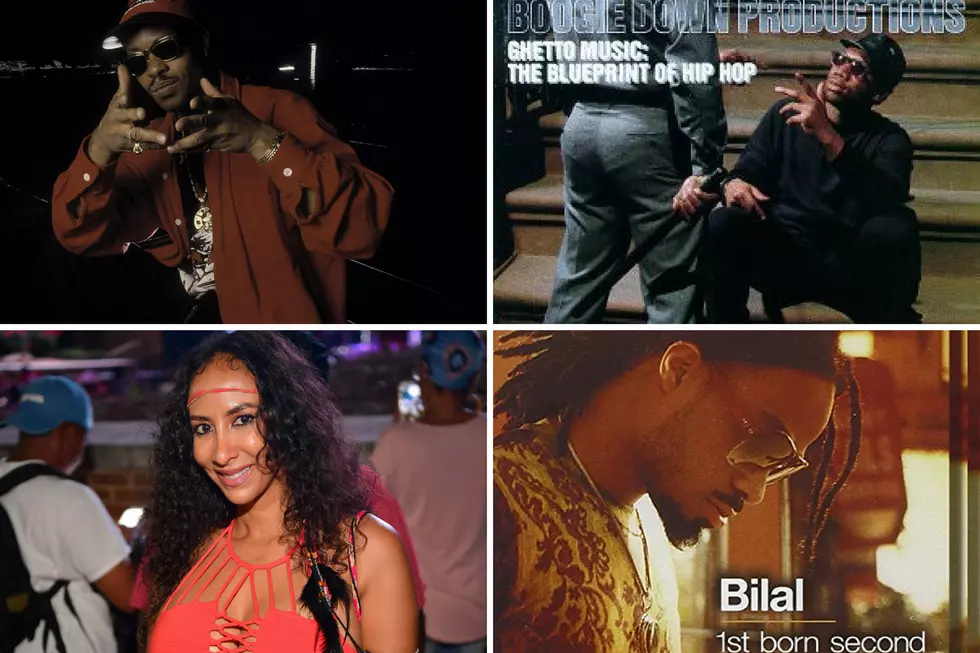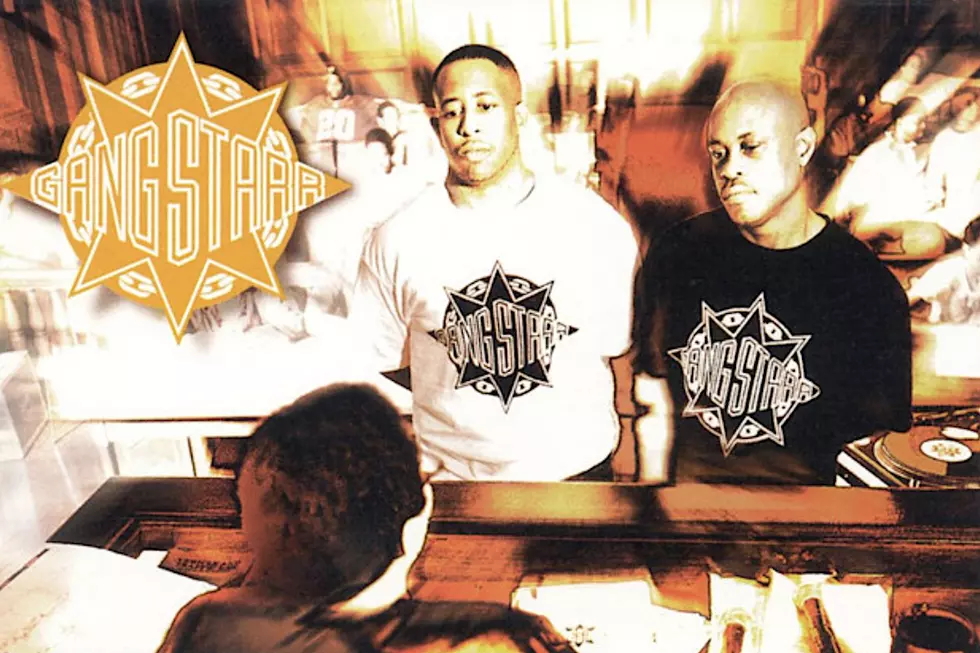
How ‘Jazzmatazz Vol. 1′ Established Guru As Rap’s Preeminent Jazz Man
Sampling has been a longstanding practice in rap music, with producers delving into various genres in search of the perfect groove or break-beat to pair with an emcee's lyrics. One of the most excellent aspects of hip-hop lies in its ability to salvage wrinkles of the past and reinvent them into something new and fresh, all while bridging the gap between generations. This would prove to be true especially during the '80s, as rap acts would utilize everything from rock-and-roll to classic soul samples in their music, resulting in many of rap's first batch of groundbreaking records.
One genre that rappers and producers would tap into heavily during the late '80s and early '90s and bring back to life would be jazz, an art-form that had lost its luster among the youth but spoke to the root of the black experience through instrumentation. While some figures in the hip-hop community would play a part in this cultural movement, one artist in particular who would help lead the charge was Gang Starr member Guru, who would experiment with marrying hip-hop and jazz throughout his legendary career.
Born in Boston, Massachusetts, Guru, who would start his career rapping under the moniker MC Keithy E. During the mid '80s, Guru would form Gang Starr with DJ 1, 2 B-Down, but the group would split, leading Guru to move to New York City and join forces with Texas native and Brooklyn transplant DJ Premier.
Releasing their debut album, No More Mr. Nice Guy, in 1989, Gang Starr would not entirely find their footing until their sophomore release, Step in the Arena, in 1991. However, one song from No More Mr. Nice Guy, "Manifest," caught the attention of movie director Spike Lee, who was so impressed its accompanying music video and the album that he reached out to the duo to contribute a song to the soundtrack to the film he was working on at the time, Mo' Better Blues. "He saw the “Manifest” video," Guru recalled during an interview. "Then he went and got our LP, No More Mr. Nice Guy, and he heard a song on there called “Jazz Music.” That was a tribute. He was working on Mo’ Better Blues already. He wanted a song like that, but more in depth. He hooked us up with Branford Marsalis."
The rap group appeared on the soundtrack on the track, "Jazz Thing." Following the release in 1990, "Jazz Thing" would further stamp Gang Starr as purveyors of the genre, which was beginning to infiltrate rap in a major way. Earlier that year, A Tribe Called Quest released their debut album, People's Instinctive Travels and the Paths of Rhythm, a record that included shades of jazz throughout, and groups like De La Soul and Digable Planets would also reach success by collaborating with and sampling jazz artists. However, in spite of their respect and homage to the genre, Gang Starr would balk at the notion of them being a "jazz rap" group. They preferred being known as a no-frills rap group devoid of gimmicks or being boxed into a trend or category, especially given their impact on the sound of east coast hip-hop.
Following the release of their third studio album, Daily Operation, in 1992, Guru and DJ Premier would go on a brief hiatus to pursue their individual endeavors. With Premo expanding his production clientele, Guru embarked on a creative journey that would culminate with Jazzmatazz Vol. 1 in May 1993.
Rap artists have worked with jazz artists before Jazzmatazz, but the album would take things a step further. With Guru calling in greats like Lonnie Liston Smith, Branford Marsalis, Ronny Jordan, Donald Byrd and Roy Ayers to contribute to the proceedings, which was indicative of the mutual respect between the jazz and hip-hop communities. "I just finished an around-the-world tour and the thing that I found, next to jazz, is that rap music is the same thing," shared Donald Byrd, a legendary trumpeter who played a core role in the making of Jazzmatazz Vol. 1. "It's being performed around the world and that everybody putting his own thing into it, so that's what makes people like Keith and what he's doing global and universal." Guru echoed those sentiments during a 1994 interview with Rap City, stating "There's similarities in the grooves. Like if you listen to a jazz record, a lot of times you can hear hip-hop sort of drum beats in there, somewhere. Young rap producers now are looking for obscure jazz records because they have that groove in there that you can find, and I think it creates atmosphere with the rap music. And it's funny because, like, rock-and-roll with rap didn't last as long because it wasn't as much you could do with it, whereas with jazz, there's a lot you can do with it."
And a lot is exactly what Guru would do on Jazzmatazz Vol. 1, an album that would stamp him as rap's preeminent jazz man and establish him as a visionary outside of Gang Starr, which some associated more with the production talents of DJ Premier than his own lyrical skills. Helming the production on the entirety of the album, Guru would showcase his talents as a board man on Jazzmatazz, beginning with "Loungin'," a sublime number on which the double-threat kicks rhymes over piano keys and horns courtesy of Donald Byrd, who rides shotgun on the track.
In addition to the musicianship and instrumentation that powers the album, Guru's passion-project is also fueled by its array of guest vocalists, all of whom compliment Guru's measured rhyme spills and stoic stanzas. N'Dea Davenport lent her talents to "When You're Near," a seductive offering which finds Guru kicking game over Simon Law's funky keys on what makes for one of Jazzmatazz Vol. 1's more infectious compositions. While the serene sonic backdrops may take center stage throughout Jazzmatazz Vol. 1, it is not at the expense of Guru's abilities, who holds court and provides visceral rhyme spills on tracks like "Transit Ride," a rollicking number that gives a tour of the NYC subway system and all that goes down within the confines of the iron horse. Guitarist Zachary Breaux and sax extraordinaire Branford Marsalis operate amid timely scratches and vocal samples,
Guru continues to keep it gutter on "Down The Backstreets," a selection that is reminiscent of his work with Gang Starr and helps center Jazzmatazz Vol. 1 while satisfying the rapper's core bass. One of the more understated offerings on the album, "Down The Backstreets" continues Jazzmatazz Vol. 1's winning streak and is a reminding of the rapper's gritty foundation while sticking to the jazz-centric script. Guru and his musical co-conspirators put forth a body of work devoid of any glaring weak spots, but one selection from the album that jumps out as the album's crown jewel is "Trust Me," which features another standout guest spot from N'Dea Davenport. Davenport turned in a syrupy hook and melodic adlibs that serve as the crux of the song. Produced by N'Dea Davenport & Guru, "Trust Me" puts a jazzy twist on James Brown's "Funky President (People It's Bad)" and is one of the few tracks to rely more on a sample than live instrumentation, but fits seamlessly within the flow of the album.
Upon its release, Jazzmatazz Vol. 1 would fly under the radar commercially, peaking at #24 on Billboard's Top R&B/Hip-Hop Albums and failing to yield any charting singles, however, the album would strengthen Guru's standing internationally, where the album was lauded and well-received, particularly in the European market. Jazzmatazz Vol. 1 would also strengthen Guru's standing within the hip-hop community among critics and fans alike, proof of his ability to flourish outside of a group dynamic while spearheading a style and sound unique of his own. While Guru will always be synonymous with DJ Premier and Gang Starr, Jazzmatazz Vol. 1 remains his most noteworthy solo effort to date and is regarded as a musical and conceptual masterpiece.
More From TheBoombox









